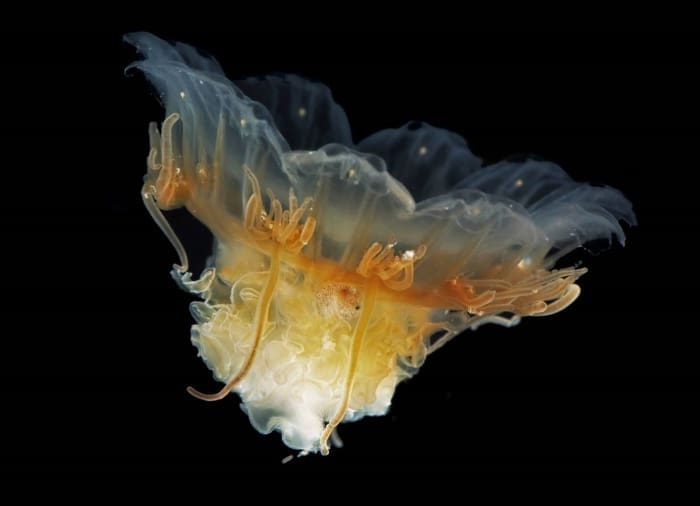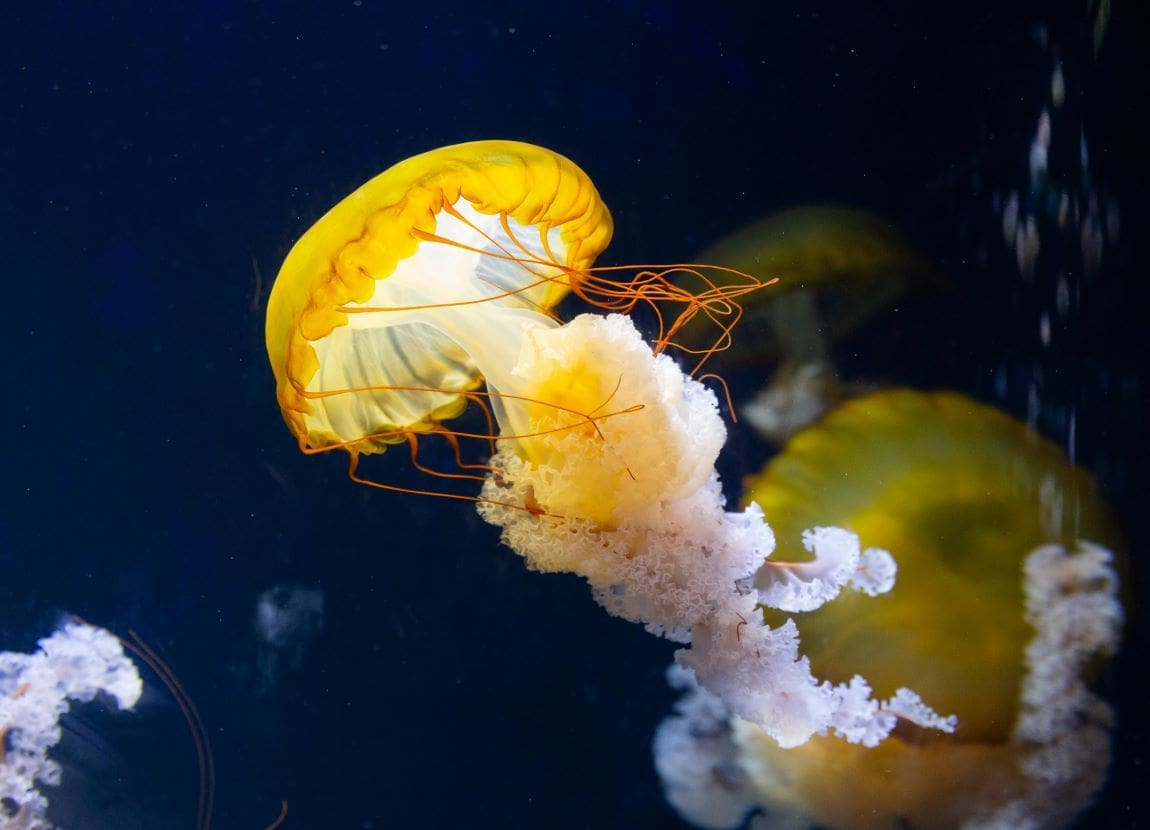For years, jellyfish were considered a trophic dead-end in marine ecosystems, serving little more than a last-resort food source for predatory fish. However, recent research conducted by a team from the Alfred Wegener Institute (AWI) and the Thünen Institute has upended this long-held belief.
The study, published in the journal Royal Society Open Science, reveals that fish in Greenlandic waters consume significantly more jellyfish than previously assumed, suggesting that jellyfish may play a more integral role in marine food webs than scientists once thought.
This discovery is particularly relevant as climate change is expected to drive the expansion of gelatinous zooplankton, such as jellyfish, into northern waters.
The Study’s Methodology and Findings
The research team, led by Dr. Charlotte Havermans, head of the ARJEL junior research group at AWI, investigated the diets of seven fish species in Greenlandic waters, including commercially important species such as Atlantic cod, haddock, and redfish.

The study utilized DNA metabarcoding, a modern technique that allows for precise identification of prey species by analyzing short gene fragments found in the stomach contents of fish. This method overcomes the limitations of traditional dietary studies, which often fail to detect gelatinous prey due to its rapid digestion.
The findings were surprising: jellyfish and other gelatinous zooplankton were present in the stomachs of all seven fish species examined, albeit in varying quantities. For two species—the greater silver smelt and the northern wolffish—jellyfish constituted the majority of their diet.
These results challenge the previous assumption that gelatinous zooplankton is merely an emergency food source with little nutritional value. Instead, the study suggests that jellyfish may be a regular and significant component of the diet for many predatory fish in these subarctic waters.
Implications for Marine Food Webs
The study’s findings have profound implications for our understanding of marine food webs, particularly in subarctic regions like Greenland. Jellyfish have traditionally been viewed as a low-energy food source, with their tissue thought to be quickly digested and of limited nutritional value.
However, the frequent consumption of jellyfish by predatory fish in Greenlandic waters suggests that their contribution to the energy budget of these fish may be greater than previously assumed.
One possible explanation for this is the abundance and availability of jellyfish. As climate change continues to warm the world’s oceans, gelatinous zooplankton are expected to become more widespread, particularly in northern waters where they are currently less dominant.
Unlike many other marine species, jellyfish are well-adapted to warmer and more acidic conditions, making them likely beneficiaries of ongoing environmental changes. As their populations increase, they may become an even more important food source for fish and other marine predators.
Dr. Havermans and her team also speculate that jellyfish may offer some nutritional advantages despite their low energy density. For example, jellyfish are relatively easy to catch compared to more agile prey, and their diet of plankton could provide energy-rich components that are beneficial to predatory fish. Yet, further research is needed to fully understand the nutritional value of jellyfish and their role in the diets of different fish species.
Climate Change and Jellyfish Proliferation
Climate change is rapidly altering marine ecosystems and jellyfish are among the species most likely to thrive in this changing environment. Rising ocean temperatures and increasing acidification are creating conditions that favor the proliferation of gelatinous zooplankton, including jellyfish.
These organisms are highly adaptable, capable of surviving and even flourishing in warmer, less oxygen-rich waters where many other species struggle.
The expansion of jellyfish populations into northern waters, as predicted by climate models, could have significant consequences for marine food webs. In ecosystems where jellyfish become more prevalent, they could shift the balance of predator-prey relationships.
As the study by Dr. Havermans and her team suggests, jellyfish may already be playing a more important role as prey than previously recognized. As their numbers increase, this role could become even more pronounced, potentially altering the diets of fish species and impacting the overall structure of marine ecosystems.
Also, the spread of jellyfish could have cascading effects throughout the food web. If jellyfish increasingly dominate the diets of predatory fish, it could reduce the pressure on other prey species, leading to shifts in the populations of various marine organisms.

Additionally, jellyfish blooms – large, often seasonal increases in jellyfish populations – can disrupt local ecosystems, affecting everything from nutrient cycling to the abundance of other species. These blooms are expected to become more frequent and widespread as the effects of climate change intensify.
Need for Further Research
The study conducted by Dr. Havermans and her team represents a crucial step in reevaluating the role of jellyfish in marine ecosystems, but it also highlights the need for further research. As Annkathrin Dischereit, the study’s first author and a doctoral student in the ARJEL group, points out, the findings provide a snapshot of fish diets at a particular point in time.
To gain a more comprehensive understanding of the trophic links between fish and gelatinous zooplankton, continuous sampling throughout the year is necessary. This would allow researchers to track how these relationships change over time and in response to environmental fluctuations.
Moreover, the study raises questions about how well scientists understand subpolar ecosystems, particularly in light of the observed increase in gelatinous zooplankton. As jellyfish populations continue to expand, their impact on marine food webs could become more pronounced, potentially altering the balance of these ecosystems in ways that are not yet fully understood.
The discovery that fish in Greenlandic waters consume jellyfish more frequently and in greater quantities than previously thought challenges long-standing assumptions about the role of gelatinous zooplankton in marine food webs.
As climate change drives the expansion of jellyfish populations into northern waters, understanding their role as prey for predatory fish becomes increasingly important. This study underscores the need to rethink the role of jellyfish in marine ecosystems and calls for further research to explore the complex relationships between fish and their gelatinous prey.
In the face of rapidly changing marine environments, gaining a deeper understanding of these dynamics is crucial for predicting how ecosystems will respond to future challenges. As jellyfish continue to spread and potentially become more integral to the diets of marine predators, their role in the food web may need to be redefined, with significant implications for the management and conservation of marine resources in subarctic and other regions.
Journal Reference:
Annkathrin Dischereit, Julia Katharina Throm, Karl-Michael Werner, Stefan Neuhaus, Charlotte Havermans, ‘A belly full of jelly? DNA metabarcoding shows evidence for gelatinous zooplankton predation by several fish species in Greenland waters’, Royal Society Open Science (2024). DOI: 10.1098/rsos.240797 | https://doi.org/10.1098/rsos.240797
Article Source:
Press Release/Material by Alfred Wegener Institute, Helmholtz Centre for Polar and Marine Research (AWI)
Featured image credit: Hung Tran | Pexels




